Sonnets and their structures
Sonnets
Sonnets originated at the Court of the Holy Roman Emperor Frederick II in Palermo, Sicily. The 13th-century poet and notary Giacomo da Lentini is credited with the sonnet’s invention and the Sicilian School of poets who surrounded him is credited with its spread.
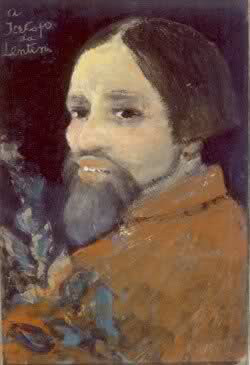
Giacomo da Lentini
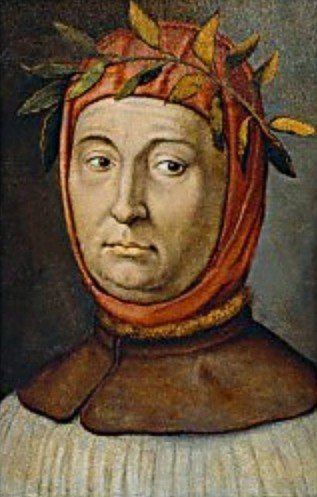
Petrarch
A sonnet is a traditional Italian love poem (a poem of appreciation). It is a genre of poetry which has 14 lines and a regular rhyming scheme. The Italian Renaissance poet, Petrarch is the 1st to introduce the poetic genre to the world. Later in the 16th century, English poets adopted the style altering its structure. Even though many poets experiment with the structure of sonnets, there are three main aspects which has not changed over time. They are;
- The line count
- The rhyming scheme
- The meter
The sonnet can thematically be divided into two sections. The first presents the theme, and raises an issue or a doubt. The second part answers the question, resolves the problem, or drives home the poem’s point. This change in the poem is called the turn and helps move forward the emotional action of the poem quickly, as fourteen lines can become too short and too fast.
Italian (Petrarchan) Sonnets
This sonnet is split into two parts, an octave and a sestet. The octave has two envelope quatrains rhyming “abba abba” (Italian octave). However, the sestet’s rhyme pattern varies in the Italian sonnet. It is most often either “cde cde” (Italian sestet) or “cdc dcd” (Sicilian sestet). The turn occurs at the end of the octave and is developed and closed in the sestet. Over the years, many sonneteers tend to prefer the Italian sonnet.
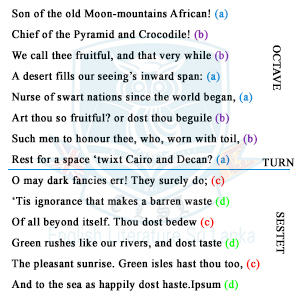
To the Nile – John Keats
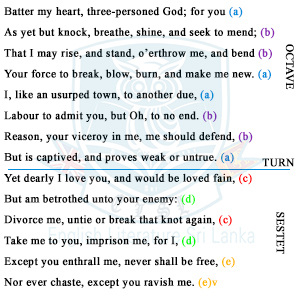
Batter My Heart – John Done
English (Shakespearian) Sonnets
This contains 3 Sicilian quatrains and one heroic couplet at the end, with an “abab cdcd efef gg” rhyme scheme. The turn comes at or near line 13, making the ending couplet quick and dramatic. However, not many modern writers have taken to writing the Shakesperean sonnet.
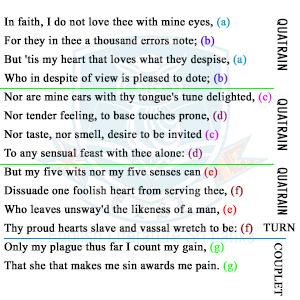
Sonnet 141– William Shakespear
Others styles of Sonnets
Spenserian Sonnets
This sonnet is very similar to the Shakespearian sonnet in form, though its rhyme scheme is slightly different. It is written with 3 Sicilian quatrains and an ending heroic couplet. It rhymes “abab bcbc cdcd ee”, such that the rhyme scheme interlocks each of the quatrains, much like the terza rima is made of interlocking triplets.
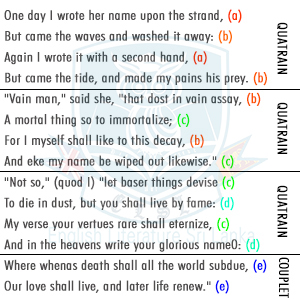
Sonnet 75 – Edmund Spencer
Spenserian Sonnets
This is made with two envelope quatrains and a sestet: “abba cddc efgefg (efefef)”. It is almost exactly like the Italian sonnet except the quatrains use different rhymes (notice both quatrains in the Italian rhyme “abba”).
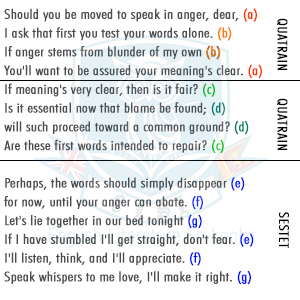
Tell Me of Your Anger in Whispers – Anon
Bowlesian Sonnets
This is an Australian sonnet, named after its creator William Lisle Bowles (1762 -1850). The sonnet has three quatrains and a heroic couplet. It is a combination of English and Petrarchan styles as the quatrains are Italian rather than Sicilian in their rhyme schemes. The Volta usually appears in the ninth and thirteenth lines similar to the English sonnet.
Some advice if you are planing to write a sonnet.
If you have a grip on the blank verse and can write a couplet, tercet, and quatrain, then the sonnet will come easy to you. Both the main (English/Italian) types are composed in three parts, so the sonnet can be simplified, in a way, by being broken down. It’s like making an outline. The turn, I find, usually takes care of itself somehow, and the more the writer worries about it, the more difficult it will be to reach. As with any poem of any kind, let the structure guide you, not vice versa. If you allow the feel and movement of the sonnet to take the poem to the next line, the turn will happen and the sonnet will be well on its way to being complete.
A sonnet is helpful when writing about emotions that are difficult to articulate. It is a short poem, so there is only so much room to work in. As well, the turn forces the poet to express what may not be normally expressable. Hopefully, you’ll find yourself saying things you didn’t know you were going to say, didn’t know you could say, but that gives you a better understanding of the emotions that drive the writing of the poem.
